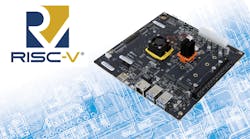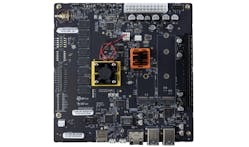This article is part of TechXchange: RISC V
What you’ll learn
- Why a RISC-V motherboard is important.
- What's on SiFive’s latest chip?
One of the popular compact motherboard form factors is the Mini-ITX. Hundreds of cases support the form factor, and most are likely to hold x86-based motherboards. There are numerous Arm motherboards as well, but, unlike the x86 motherboards, they typically require a customized operating system due to less standardization in this space.
Linux tends to be the norm for Arm-based solutions, and there’s often an array of Linux distributions to choose from. Low-power solutions are typically the reason why designers opt for an Arm-based platform. However, it’s often the functionality of the system-on-chip (SoC) at the core of the platform that makes the difference.
One platform that’s presenting a challenge to Arm is RISC-V. Like most Arm solutions, RISC-V platforms are licensed from a standard platform such as an Arm Cortex-A76. The big difference is that RISC-V is a really just an instruction-set specification that’s open, so anyone can create an implementation. And a number of companies are going in the direction, including SiFive.
Like Nvidia’s Arm, SiFive is in the business of selling CPU IP. Much of this winds up in custom SoC solutions, but that makes it hard for developers to check out the platform or deploy it without having their own chip made, which isn’t an inexpensive exercise. The plethora of x86 and Arm Cortex-M and Cortex-A platforms highlights how important real hardware is to the growth of an echo system.
SiFive has actually been involved in the hardware business, starting with the 32-bit RV32IMAC Freedom E310. The RV32IMAC designation is an abbreviation for the standard RISC-V features, including 32-bit support (RV32), integer support (I), hardware integer multiplication and division (M), atomic real-time instructions (A), and support for the 32-bit and compact (C) 16-bit instruction set. The chip has 16 32-bit registers and no hardware stack. As with many RISC systems, it uses a jump-and-link (JAL) instruction to save a return address in a register.
The E310 would be on par with an Arm Cortex-M solution, which has a memory protection unit (MPU) but not a memory management unit (MMU) that’s found in Arm Cortex-A platforms that can run operating systems like Linux. RISC-V is an extensible instruction set that supports MMUs, virtualization, and 64-bit platforms among other features. SiFive and other RISC-V IP vendors have been delivering 64-bit, MMU RISC-V solutions for a while, and they have found their way into numerous SoC solutions, but, again, typically for a captive audience.
RISC-V Mini-ITX Motherboard
That long-winded introduction is to highlight the significance of SiFive’s latest announcement for the embedded space. I expect to eventually see more standard form-factor solutions like this in the future—the rise of RISC-V and this board has occurred a few years from RISC-V really taking off, which is impressive.
SiFive’s HiFive Unmatched Mini-ITX motherboard holds the company’s FU740 SoC (see figure). The FU740 is built around four SiFive U74 cores and one SiFive S7 core in a SMP configuration like Arm’s big.LITTLE approach, which is now Arm’s DynamiQ architecture. The main shared memory is 8 GB of DDR4. It also incorporates a 32-MB QSPI flash and microSD card for booting the system.
As with most Mini-ITX boards, there’s a single PCIe slot with a x8 PCIe Gen 3 interface. Furthermore, two M.2 slots are in the mix: one is a shorter version suitable for interface cards, such as wireless support, while the longer version can handle everything up to a PCIe Gen 3 x4 M.2 device, such as an NVMe SSD. Four USB 3.2 Gen 1 Type A ports are available on the rear panel along with a micro-USB Type B and a 1-Gb Ethernet port.
The board uses a standard ATX power-supply connector, facilitating its use with standard Mini-ITX cases. Board pricing starts at $665, including a microSD card with a custom version of Linux.

